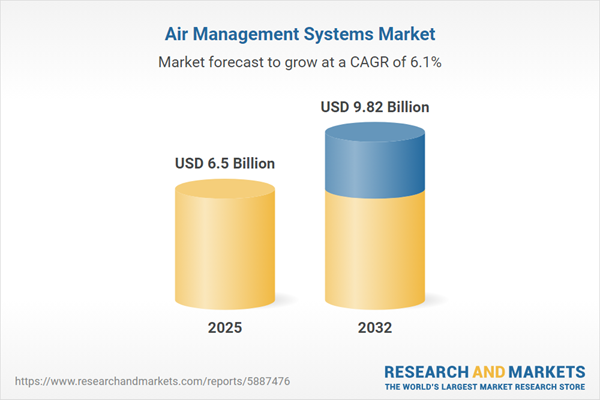Speak directly to the analyst to clarify any post sales queries you may have.
Senior leaders increasingly view air management systems as vital components of business resilience strategies, driven by evolving compliance mandates and a heightened focus on workforce well-being. As organizations adapt, integrated solutions are transforming the way environments are managed across all industries.
Market Snapshot: Air Management Systems Market
The global air management systems market is on a steady upward path, with a valuation of USD 6.12 billion and projected to reach USD 6.50 billion by 2025 and USD 9.82 billion by 2032. This reflects a compound annual growth rate of 6.09%. Several factors drive this momentum: adapting to ever-changing regulations, widespread implementation of advanced mechanical and intelligent technologies, and a persistent organizational priority to maintain secure indoor environments. Businesses now leverage integrated solutions—combining filtration, ventilation, and cloud-based controls—not merely for compliance, but as a fundamental aspect of long-term operational planning and strategic risk management.
Scope & Segmentation of the Air Management Systems Market
This report presents a structured framework tailored for senior decision-makers navigating a diverse, innovation-driven market. Understanding segment nuances supports precise investment and technology adoption:
- Product Types: Advanced filtration systems, such as high-efficiency HEPA and activated carbon units, address complex airborne threats. Comprehensive HVAC options—including both modular and central configurations—deliver scalability for facilities of varying sizes. Analytics-centric monitoring platforms, resilient pressure regulators, and adaptable ventilation technologies empower tailored, site-specific solutions.
- Distribution Channels: Organizations can leverage aftermarket enhancements, direct-from-manufacturer sourcing, digital procurement channels for transparency, and collaborations with suppliers and OEMs to optimize system lifespan and ongoing performance.
- Installation Types: Scalable offerings meet needs for both new construction and retrofitting of legacy systems, enabling modernization and enhancing flexibility in dynamic regulatory environments.
- Geographies: The market encompasses North America, Latin America, Europe, the Middle East & Africa, and Asia-Pacific. Each region confronts distinct climate requirements, compliance obligations, and technological preferences, shaping localized deployment and investment strategies.
- Leading Companies: Key industry players are recognized by their innovation capabilities and agile approaches to complex global air management scenarios, positioning themselves as valuable partners for senior leadership.
This segmentation equips executives to synchronize technology choices with operational demands, balancing regional compliance and global supply chain dependencies.
Key Takeaways for Senior Decision-Makers
- Integrated air management strategies are overtaking disconnected systems, supporting robust risk management and safer workplaces.
- Smart sensors and data analytics facilitate real-time condition assessments and preventive maintenance, giving organizations actionable insights for efficiency gains.
- Strengthening supply chain diversification across regions can improve resilience and mitigate risks related to fluctuating material availability and trade changes.
- Modernizing and retrofitting existing infrastructures enables compliance agility without significant operational disruption.
- Collaborative initiatives between property owners, technology vendors, and service organizations foster swift campaigns to enhance sustainability and drive cross-portfolio efficiencies.
Tariff Impact on the Air Management Systems Market
Recent shifts in U.S. tariff policy have increased costs for critical materials and components within air management systems. Enterprises are adapting their procurement strategies by turning to regional suppliers, streamlining operational procedures, and expanding domestic assembly capabilities. This approach helps maintain consistent supply chains and supports uninterrupted business activity amid evolving regulatory and trade environments.
Methodology & Data Sources
Findings draw on input from senior executives, up-to-date regulatory analysis, industry benchmarking, and practical case studies. This holistic methodology ensures recommendations reflect current trends and operational realities in the air management systems sector.
Why This Report Matters
- Provides clear, actionable insights for navigating complex and evolving compliance requirements in air management environments.
- Highlights the benefits of integrating intelligent technologies and regional supply networks for improved operational agility and reliability.
- Supports consistent facility management practices that align with top-tier standards, enabling organizations to ensure secure indoor environments across diverse locations.
Conclusion
Executive teams gain the perspective to lead confidently through shifting air quality regulations, plan future-ready investments, and sustain organizational adaptability as compliance demands evolve.
Additional Product Information:
- Purchase of this report includes 1 year online access with quarterly updates.
- This report can be updated on request. Please contact our Customer Experience team using the Ask a Question widget on our website.
Table of Contents
3. Executive Summary
4. Market Overview
7. Cumulative Impact of Artificial Intelligence 2025
Companies Mentioned
The companies profiled in this Air Management Systems market report include:- Daikin Industries, Ltd.
- Carrier Global Corporation
- Trane Technologies PLC
- Johnson Controls International PLC
- Siemens AG
- Honeywell International Inc.
- Panasonic Corporation
- LG Electronics Inc.
- Emerson Electric Co.
Table Information
| Report Attribute | Details |
|---|---|
| No. of Pages | 197 |
| Published | November 2025 |
| Forecast Period | 2025 - 2032 |
| Estimated Market Value ( USD | $ 6.5 Billion |
| Forecasted Market Value ( USD | $ 9.82 Billion |
| Compound Annual Growth Rate | 6.0% |
| Regions Covered | Global |
| No. of Companies Mentioned | 10 |









